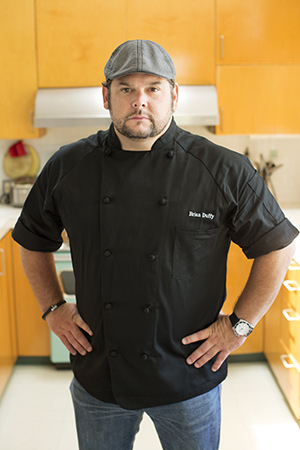
Brian Duffy is best known as one of the culinary experts on the Spike TV show “Bar Rescue,” but he earned his chops in the restaurant business.
After studying at The Restaurant School at Walnut Hill College in Philadelphia, he got fine-dining training at The Four Seasons in Philadelphia under Jean-Marie LaCroix before becoming a partner in Kristopher’s, a BYOB concept in Philadelphia. He later became corporate executive chef at the Dave Magrogan Group, which ran Doc Magrogan’s Oyster House, Harvest Season Grill & Wine Bar and Kildare’s Irish Pub.
Duffy is currently a consultant, developing fresh and frozen seafood products for Seafood America and advising restaurants on how to improve their business.
He recently shared nine tips for running a restaurant with Nation’s Restaurant News.
1. Hold pre-shift meetings.
“I do a pre-meal before every shift,” Duffy said.
This isn’t a time to harangue or lecture people — discipline should be done in private, he said.
“It’s a time for positive energy. It’s basically a coach job: You want to get them excited to run the next shift,” he said.
Sometimes he’ll introduce a contest — a prize for whoever sells the most pie, for example. He might also cook one of the restaurant’s core dishes, tell them what’s in it and how to serve it.
For example, “If it’s a stew, there should be a spoon at the table,” Duffy said.
Also, by knowing what’s in the food, staff can address any allergies immediately, “So if someone says, ‘Hey, I have a gluten allergy,’ they can say, ‘No, you can’t have the stew because it’s made with a roux.’”
2. Plan for special events and holidays.
Duffy tries to work six weeks ahead. For instance, he starts planning for St. Patrick’s Day in early February. He said that is when you should ask, “Have we hired the Irish step dancers or the bagpipes?”
In early December, he develops specials for the Super Bowl and plans ways to keep customers in the bar after the game is over. He creates an action list and delegates jobs to different people.
3. Mission statements matter.
Duffy writes mission statements and core values for all of his clients. If a client’s mission is to consistently provide an authentic German experience, then the whole staff needs to know that, he said.
“If you don’t have that posted, then nobody has the same idea that you do,” he said.
4. Take your time and do your research when introducing new menu items.
“I always ask, ‘Who is developing your menu?’ Is it a 24-year-old with grandiose ideas, or the owner who thinks his grandmother’s meatballs are the best thing, even though he doesn’t sell that many?”
Neither one is a great choice, Duffy said. Instead, get your customers involved. Run specials for weeks at a time to get an idea not only if customers will try them, but if they’ll order them again. Give comment cards to guests, too.
“I don’t even want their name. I just want them to tell me what they think,” he said.
Duffy also suggests throwing parties for regular customers to have them taste new menu items.
Handling hiring, marketing
(Continued from page 1)
5. Your staff members are your best marketers. Tap into them.
“I had a client in California, great guy, 55 years old. He kept saying ‘I’m not hitting the clientele I want to hit,’” Duffy said.
The client was trying to reach 21-year-olds with karaoke, bingo and family-friendly movie nights.
Meanwhile, he had a staff of young servers and bartenders who would hit three bars each night after their shift. Duffy wondered why he wasn’t asking them what they were looking for at those bars.
“A lot of people fail because they don’t tap into people working directly with them,” Duffy said.
6. Take your time when hiring.
“A lot of hiring is done to alleviate stress,” Duffy said. “Someone calls in sick, so the owner asks the dishwasher to call one of his buddies to work. There’s no interview or reference check, and that’s no way to get good staff.”
7. Share your budget.
“A lot of owners are afraid to share what their sales goals are, which just baffles me,” Duffy said.
Instead, management should tell their staff what their sales goals are at each pre-shift meeting. Also, explain your balance sheet to chefs and hold them to targeted food costs.
“Too many chefs are culinary chefs, but they’re not business chefs,” he said. “They’re cooking for a living, but they don’t realize how much the business costs.”
8. Have uniforms.
“Individuality creates chaos,” Duffy said, if for no other reason than that customers need to know who works at the restaurant and who doesn’t.
“Not only that, but it’s your brand,” he said.
9. Understand social media.
“Ninety percent of the Facebook updates I see are sales-y,” he said, and most of them aren’t even very good at selling.
“Happy Hour today 5-7. Come see us!” is not a good Facebook post. “There’s no engagement,” he said.
Duffy starts posting about happy hour between 8:30 and 9:30 in the morning, when people are arriving at work and checking their Facebook pages.
“I say, ‘Hey, we’re running a happy hour special today. What do you want us to do?’”
By engaging with his audience, he gets their attention and also gives them a sense of ownership in the situation, which will make them more likely to come to his happy hour.
This story has been revised to reflect the following update:
Update: Sept. 4, 2014 This story has been updated to include the company for which Duffy has developed seafood products. It is Seafood America.
Contact Bret Thorn at [email protected].
Follow him on Twitter: @foodwriterdiary





